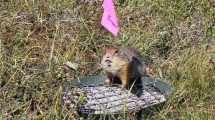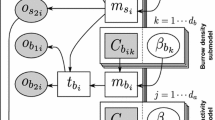Abstract
Factors affecting the population density and daily pattern of activity of the European ground squirrelSpermophilus citellus (Linnaeus, 1766) were studied in two habitats of the Kiskunság National Park, Hungary. One habitat was dominated by sandy and the other by salty grassland. Population densities were estimated by counting ground squirrel burrow entrances in sample areas with different microhabitat characteristics. Three categories (elevated, level and depressed) were used to describe the spatial distribution of burrows according to microtopography. Daily activity was evaluated by counting the ground squirrels visible on the surface and registering their alarm calls. The highest proportion of ground squirrel holes was found on elevations in the two habitats. Ground squirrels showed a similar daily activity pattern in different areas and in the same season in consecutive years. The daily activity consisted in a morning peak, a midday pause and a less regular afternoon activity period. Human activity had no direct effect on the daily activity pattern. Emission of alarm calls peaked in June, when litters emerge from the maternal burrows.
Similar content being viewed by others
References
Arenz C. L. and Leger D. W. 1997. Artificial visual obstruction, antipredator vigilance, and predator detection in the thirteen-lined ground squirrel (Spermophilus tridecemlineatus). Behaviour 134: 1101–1114.
Aschoff J. 1966. Circadian activity pattern with two peaks. Ecology 47: 657–662.
Bélanger L. and Bédard J. 1989. Responses of staging greater snow geese to human disturbance. The Journal of Wildlife Management 53: 713–719.
Bennett W. A. 1990. Scale of investigation and the detection of competition: an example from the house sparrow and house finch introductions in North America. American Naturalist 135: 725–747.
Brillhart D. B. and Kaufmann D. V. 1991. Influence of illumination and surface structure on space use by prairie deer mouse (Peromyscus maniculatus bairdii). Journal of Mammalogy 72: 764–768.
Drickamer L. C. 1990. Microhabitat preferences of two species of deermicePeromyscus in a northeastern United States deciduous hardwood forest. Acta Theriologica 35: 241–252.
Everts L. G., Strijkstra A. M., Hut R. A., Hoffmann I. E. and Millesi E. 2001. Seasonal variation in daily activity patterns of free-ranging European ground squirrels (Spermophilus citellus). [In: Natural entrainment of circadian system. R. A. Hut, ed]. University of Groningen, Haren: 15–27.
Gerkema M. P. and Verhulst S. 1990. Warning against an unseen predator: a functional aspect of synchronous feeding in the common vole,Microtus arvalis. Animal Behaviour 40: 1169–1178.
Harper S. J. and Batzli G. O. 1996. Effects of predators on structure of the burrows of voles. Journal of Mammalogy 77: 1114–1121.
Heschl A. 1993. On the ontogeny of seed harvesting techniques in free ranging ground squirrels. Behaviour 125: 39–50.
Hubbs A. H., Karels T. and Boonstra R. 2000. Indices of population size for burrowing mammals. The Journal of Wildlife Management 64: 296–301.
Hut R. A. and Scharff A. 1998. Endoscopic observations on tunnel blocking behaviour in the European ground squirrel (Spermophilus citellus). Zeitschrift für Säugetierkunde 63: 377–380.
Hut R. A., van Oort B. E. H. and Daan S. 1999. Natural entrainment without dawn and dusk: the case of the European ground squirrel (Spermophilus citellus). Journal of Biological Rhythms 14: 290–299.
Kis J., Váczi O., Katona K. and Altbäcker V. 1998. The effect of vegetation height on the density of European ground squirrels (Spermophilus citellus) in a Hungarian reintroduced population. Természetvédelmi Közlemények 7: 117–123. [In Hungarian with English summary]
Koehler D. K. and Stanley H. A. 1991. Habitat use and food selection of small mammals near a sagebrush/crested wheatgrass interace in southeastern Idaho. Great Basin Naturalist 51: 249–255.
Krebs C. J. 1994. Ecology: the experimental analysis of distribution and abundance, 4th ed. Harper Collins College Publishers, New York: 1–801.
Kryštufek B. 1993. European sousliks (Spermophilus citellus, Rodentia, Mammalia) of Macedonia. Scopolia 30: 1–19.
McCarley H. 1966. Annual cycle, population dynamics and adaptive behaviour ofCitellus tridecemlineatus. Journal of Mammalogy 47: 294–316.
Millesi E., Huber S., Everts I. and Dittami J. P. 1999a. Reproductive decisions in female European ground squirrels: factors affecting reproductive output and maternal investment. Ethology 105: 163–175.
Millesi E., Strijkstra A. M., Hoffmann I. E., Dittami J. P. and Daan S. 1999b. Sex and age differences in mass, morphology and annual cycle in European ground squirrels,Spermophilus citellus. Journal of Mammalogy 80: 218–231.
Mitchell-Jones A. J., Amori G., Bogdanowicz W., Kryštufek B., Reijnders P. J. H., Spitzenberger F., Stubbe M., Thissen J. B. M., Vohralík V. and Zima J. 1999. The atlas of European mammals. Academic Press, London: 1–484.
Mrosovsky N. 1968. The adjustable brain of hibernators. Scientific American 218: 110–118.
Parer I. and Libke J. A. 1985. Distribution of rabbit,Oryctolagus cuniculus, Warrens in relation to soil type. Australian Wildlife Research 12: 387–405.
Powell K. L., Robel R. J., Kemp K. E. and Nellis M. D. 1994. Aboveground counts of black-tailed prairie dogs: temporal nature and relationship to burrow entrance density. The Journal of Wildlife Management 58: 361–366.
Rayor L. S. 1985. Effects of habitat quality on growth, age of first reproduction, and dispersal in Gunnison’s prairie dogs (Cynomys gunnisoni). Canadian Journal of Zoology 63: 2835–2840.
Schwagmeyer P. L. 1980. Alarm calling behavior of the thirteen-lined ground squirrel,Spermophilus tridecemlineatus. Behavioural Ecology and Sociobiology 7: 195–200.
Severson K. E. and Plumb G. E. 1998. Comparison of methods to estimate population densities of black-tailed prairie dogs. Wildlife Society Bulletin 26: 859–866.
Sherman P. W. 1977. Nepotism and the evolution of alarm calls. Science 197: 1246–1253.
Sinclair A. R. E. 1986. Testing multi-factor causes of population limitation: an illustration using snowshoe hares. Oikos 47: 360–364.
Tóth K. (ed) 1979. [National park in the Kiskunság]. Natura, Budapest: 1–520. [In Hungarian]
Van Horne B., Schooley R. L., Knick S. T., Olson G. S. and Burnharn K. P. 1997. Use of burrow entrances to indicate densities of Townsend’s ground squirrels. The Journal of Wildlife Management 61: 92–101.
Van Horne B. and Sharpe P. B. 1998. Effects of tracking by armored vehicles on Townsend’s ground squirrels in the Orchard Training Area, Idaho, USA. Environmental Management 22: 617–623.
Villafuerte R. and Moreno S. 1997. Predation risk, cover type, and group size in European rabbits in Doana (SW Spain). Acta Theriologica 42: 225–230.
Vitale A. F. 1989. Pattern of dispersion of young wild rabbits,Oryctolagus cuniculus L., in relation to burrows. Ethology 83: 306–315.
Vispo C. R. and Bakken G. S. 1993. The influence of thermal conditions on surface activity of thirteen-lined ground squirrels. Ecology 74: 377–389.
Watson M. and Clarke R. 2000. Saker falcon diet: the implications of habitat change. British Birds 93: 136–143.
Wecker S. C. 1964. Habitat selection. Scientific American 211: 109–116.
Yensen E., Quinney D. L., Johnson K., Timmerman K. and Steenhof K. 1992. Fire, vegetation changes, and population fluctuations of Townsend’s ground squirrels. American Midland Naturalist 128: 299–312.
Author information
Authors and Affiliations
Corresponding author
Rights and permissions
About this article
Cite this article
Katona, K., Váczi, O. & Altbäcker, V. Topographic distribution and daily activity of the European ground squirrel population in Bugacpuszta, Hungary. Acta Theriol 47, 45–54 (2002). https://doi.org/10.1007/BF03193565
Received:
Accepted:
Issue Date:
DOI: https://doi.org/10.1007/BF03193565




